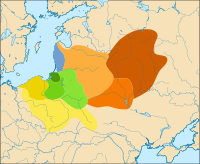Milograd culture
This article may be expanded with text translated from the corresponding article in Polish. (November 2016) Click [show] for important translation instructions.
|
This article needs additional citations for verification. (July 2016) |

Baltic cultures from 600-200 BC:
Sambian-Nothangian group
Western Masurian group (Galindians)
Eastern Masurian group (Yotvingians)
Lower Neman and West-Latvian group (Curonians)
Brushed Pottery culture
Milograd culture
Plain-Pottery culture/Dnepr-Dvina culture
Bell-shaped burials group
The Milograd culture (also spelled Mylohrad, also known as Pidhirtsi culture on Ukrainian territory) is an archaeological culture, lasting from about the 7th century BC to the 1st century AD. Geographically, it corresponds to present day southern Belarus and northern Ukraine, in the area of the confluence of the Dnieper and the Pripyat, north of Kyiv. Their ethnic origin is uncertain.
The town of Milograd, after which the culture is named, is located in the Homiel Province of the Belarus republic.
See also[]

Archaeological Cultures, eastern Europe, c. mid 8th century BC
- Middle Dnieper culture
- Pomeranian culture
- Zarubintsy culture
- Przeworsk culture (Middle and Upper Vistula with Rightbank Oder)
- Chernoles culture (Pripyat' basin, Middle Dnieper and part of Upper Dnieper)[1]
References[]
- ^ Theory of V. Sedov about Slavic Homeland; "Archived copy". Archived from the original on 2014-01-11. Retrieved 2014-01-11.
{{cite web}}: CS1 maint: archived copy as title (link)
External links[]
- Scythians/Sacae by Jona Lendering
Categories:
- Archaeological cultures of Eastern Europe
- Iron Age cultures of Europe
- Baltic archaeological cultures
- Slavic archaeological cultures
- Archaeological cultures in Belarus
- Archaeological cultures in Ukraine
- Belarusian history stubs
- Ukrainian history stubs